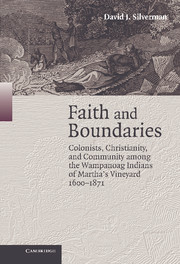 Faith and Boundaries
Faith and Boundaries Published online by Cambridge University Press: 17 December 2010
The inspiration for this study came, innocently enough, with a walk along a stone wall. Linda, my fiancé (now my wife), and I were on a late May vacation after I had finished my first year of graduate school. Short of money and in desperate need of some time outside, we were lucky to have a week at a ramshackle timeshare on the island of Martha's Vineyard, just off Cape Cod in Massachusetts. I wanted this trip to be a diversion from my studies of early America, and when the island greeted us with glorious sun and lilac-perfumed sea air I knew it would not disappoint. No sooner had we set down our bags than we ventured out for a hike, unwilling to watch the day pass. An arbitrarily chosen trail led us winding through scrub pine and oak trees, past the weed-choked foundations of a colonial-era farmstead, and up a gradual peak, until it ended at a boulder split by a deep diagonal crack sitting atop a wooded hill. This landmark, our tourist literature explained, was called Waskosim's Rock and figured prominently in the oral tradition of the island's Indians, a group that I mistakenly assumed – as I soon discovered much to my embarrassment – had disappeared several generations ago, leaving whatever stories they once told about this monument to conjecture now.
To save this book to your Kindle, first ensure [email protected] is added to your Approved Personal Document E-mail List under your Personal Document Settings on the Manage Your Content and Devices page of your Amazon account. Then enter the ‘name’ part of your Kindle email address below. Find out more about saving to your Kindle.
Note you can select to save to either the @free.kindle.com or @kindle.com variations. ‘@free.kindle.com’ emails are free but can only be saved to your device when it is connected to wi-fi. ‘@kindle.com’ emails can be delivered even when you are not connected to wi-fi, but note that service fees apply.
Find out more about the Kindle Personal Document Service.
To save content items to your account, please confirm that you agree to abide by our usage policies. If this is the first time you use this feature, you will be asked to authorise Cambridge Core to connect with your account. Find out more about saving content to Dropbox.
To save content items to your account, please confirm that you agree to abide by our usage policies. If this is the first time you use this feature, you will be asked to authorise Cambridge Core to connect with your account. Find out more about saving content to Google Drive.